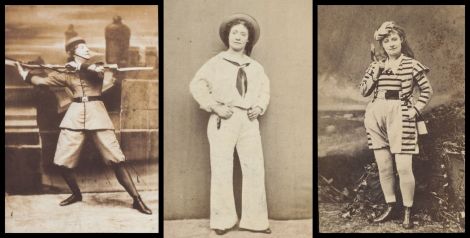Lydia Thompson, the father of all drag kings
By Bobster
When Lydia Thompson and her “British Blondes” first stepped onto the New York stage in 1868, audiences went wild. Not only were they being introduced to a rowdy English version of the entertainment called burlesque, but here were women in masculine clothes playing men’s roles. The city had never seen anything quite like it.

Photos from the Victoria & Albert Museum, London
Today’s drag kings are spiritual heirs of Lydia Thompson, who became one of the biggest stars on both sides of the Atlantic in her era. Born in 1838, the daughter of a London public-house keeper, she began dancing professionally as a teenager and performed across Europe. “She was charming to look at, a good singer, a really clever dancer, and the life and soul of the scene while on the stage,” according to author Errol Sherson.
Thompson was still in her 20s when she began performing in drag regularly. She played Max in a burlesque of Weber’s Der Freischütz (1866), as Prince Buttercup in The White Fawn, as Massaroni in the burlesque The Brigand, and as Prince Florizel in another burlesque, Perdita.
Having attained fame on the London stage, she crossed the ocean to conquer America. “The eccentricities of pantomime and burlesque – with their curious combination of comedy, parody, satire, improvisation, song and dance, variety acts, cross-dressing, extravagant stage effects, risqué jokes and saucy costumes – while familiar enough to British audiences, took New York by storm,” writes Signe Hoffos.

According to GLBTQ.com, in the mid-nineteenth century this theatrical form was associated primarily with parody of high culture through puns, wordplay, and nonsense.
Posted by Bobster on June 15th, 2009 at 08:00 am




